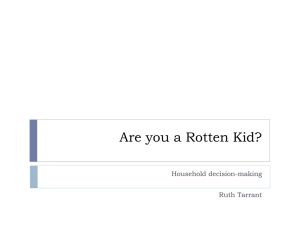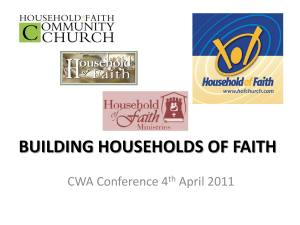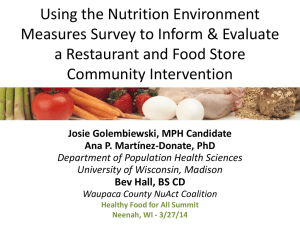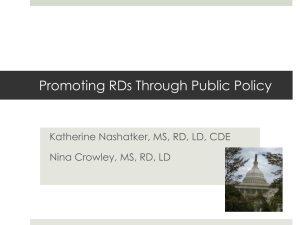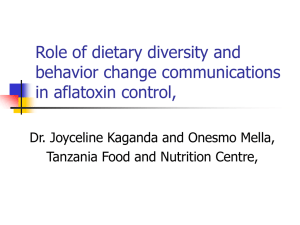Document
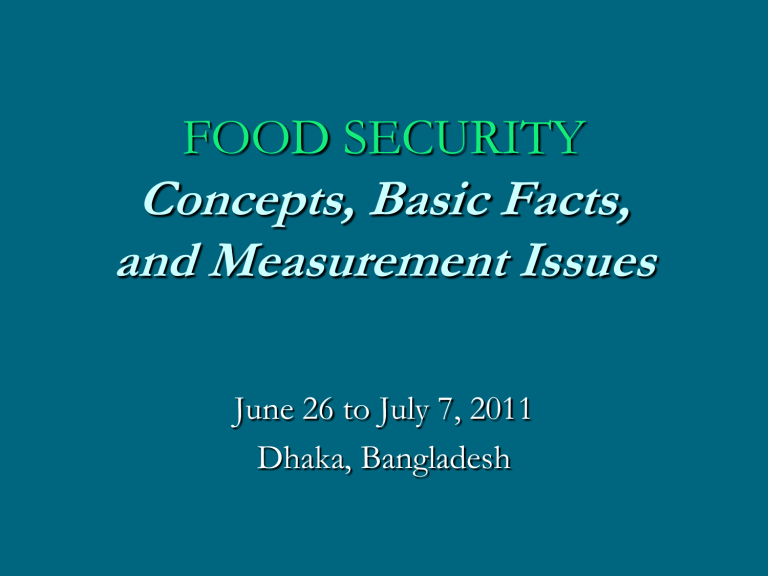
FOOD SECURITY
Concepts, Basic Facts, and Measurement Issues
June 26 to July 7, 2011
Dhaka, Bangladesh
Kazal 6e:
Data Sources, Uses, and Limitations in
Bangladesh
Learning: Trainees will become familiar with the available secondary sources of data on food security in Bangladesh. They will learn about the uses of the data depository as well as its limitations in analyzing various dimensions of food security in Bangladesh.
Brief Contents
• data sources for food security analysis and mapping
Household Income and Expenditure Survey
Poverty Monitoring Survey
Child Nutrition Survey
Demographic and Health survey
Multiple Indicator Cluster Survey
Nutrition Surveillance Project, HKI/IPHN
• Bangladesh: National Household Survey Report on Food Secur ity
• metadata for national agricultural statistics
major domains and selected indicators of agricultural statistics
coverage, availability, data sources and responsible agencies
• Food Balance Sheets of the Food and Agriculture Organization
• application of the data sets
• limitations of the data sets
Data sources for food security analysis and mapping
Household Income and Expenditure Survey
Poverty Monitoring Survey
Child Nutrition Survey
Demographic and Health survey
Multiple Indicator Cluster Survey
Nutrition Surveillance Project, HKI/IPHN
Household Income and Expenditure Survey
Household and Population
Characteristics
Basic Needs Indicators
Income and Expenditure
Consumption of Food
Measurement of Poverty
Education
Health
Social Safety Nets
Programs
Selected Community
Characteristics
New Features of 2010 HIES
Microcredit
Disability
Migration & Remittance and
Crisis Management ( Shocks & Coping)
Poverty Monitoring Survey
Poverty Line and Poverty Incidence
Household Income and
Expenditure
Nutrition and Welfare
Landownership and Occupation
Household Characteristics
Health, sanitation and
Education
Credit
Gender Dimension
Expenditure Saving
Crisis and Crisis Coping
Child & Mother Nutrition Survey
• Household characteristics
• Characteristics of Mothers
• Knowledge and Practicees on Child and
Maternal Care
• Child Nutrition Status
• Maternal Nutrition Status
Bangladesh Demographic and Health Survey
• Household population and housing characteristics
• Characteristics of survey respondents
• Fertility
• Fertility regulation
• Other proximate determinants of fertility
• Fertility preferences
• Infant and child mortality
• Maternal and newborn health
• Child health
• Nutrition of children and women
• Hiv/aids-related knowledge, attitudes, and behavior
• Women’s empowerment and demographic and
• Health outcomes
• Domestic violence
Multiple Indicator Cluster Survey
(Monitoring the situation of children and women)
• Nutrition
• Child Health
• Environment
• Reproductive Health
• Child Development
• Education
• Child protection
• HIV/AIDS, Sexual Behaviour, and Orphaned and Vulnerable
Children
Poverty mapping methods
Small area estimation
Household unit level method
Community level data method
Multivariate weighted basic needs index
Principal components
Principal components over time
Factor analysis
Ordinary Least Squares
Combination of qualitative information and secondary data
Primarily qualitative
Primarily secondary
Statistical analysis of qualitative information combined with secondary data
Poverty
mapping methods
Extrapolation of participatory approaches
Direct measurement of household survey data
Direct measurement of census data
Income data
Basic needs index
Z scores
Statistical Yearbook of Bangladesh / Statistical
Pocket Book of Bangladesh
•
• General Features and Environment
• Area, Population, Household and Household Characteristics
• Labor and Manpower
• Agriculture: Crops, Livestock, Forestry and Fishery
• Industry
• Energy
• Transport and Communication
• Foreign Trade
• Finance Foreign and Banking, Co-operative and Credit Distribution
• Prices and wages
• National Income
• Education
• Health, Family planning and Social Statistics
• Consumption: Household Income and Expenditure
Bangladesh Household Food Security and Nutrition
Assessment Report 2009
The broad objective was: to analyze the impact of the food price hikes on food production and nutrition / health status, in order to suggest response options and recommendations
Specific objectives
• Aspects of food security & nutrition including food markets
• Household food access and food utilization
• Nutrition and health
• Water and sanitation
Survey conducted by:
World Food Programme, UNICEF,
Institute of Public Health Nutrition,
Institute of Public Health Nutrition, MoHFW
METADATA FOR
NATIONAL AGRICULTURAL STATISTICS
Major domains and selected indicators of agricultural statistics
METADATA FOR
NATIONAL AGRICULTURAL STATISTICS
Major domains and selected indicators of agricultural statistics
METADATA FOR
NATIONAL AGRICULTURAL STATISTICS
Major domains and selected indicators of agricultural statistics
Coverage, Availability, Data Sources and
Responsible Agencies
Production
Coverage, Availability, Data Sources and Responsible
Agencies
Production
Coverage, Availability, Data Sources and Responsible
Agencies
Trade
Coverage, Availability, Data Sources and Responsible
Agencies
Food Consumption
Coverage, Availability, Data Sources and Responsible
Agencies
Fertilizer
Coverage, Availability, Data Sources and Responsible
Agencies
Pesticides
Coverage, Availability, Data Sources and Responsible
Agencies
Land Use
Coverage, Availability, Data Sources and Responsible
Agencies
Labour and Employment
Bangladesh: National Household Survey
Report on Food Security
household profile
household purchasing power
household expenditure pattern
food acquisition, distribution and consumption
housing and facilities
household health status
food production
level of community participation
perception on food security indicators, and
community problems.
The Food Balance Sheets of the Food and Agriculture
Organization: A Review of Potential Ways to Broaden the
Appropriate Uses of the Data
FAO suggests that the data may be used to:
observe a country’s food supply and its trends
compare food supply to nutritional requirements for healthy diets
estimate supply/shortage measures evaluate food and nutrition policies
measure the degree of chronic undernutrition
examine changes in diet patterns
investigate relationships between food supplies, famine, and malnutrition
calculate self-sufficiency and import-dependency ratios
set goals for trade and production and project future supply and demand.
Application of the data sets
Research
Monitoring and evaluation
Policy options
Limitations of the data sets
Formation of survey local committees
Organization period of time
Data collection and supervision of field work
Data processing and dissemination
Data validatity, Reliability and authenticity
Timely availability of data sets

